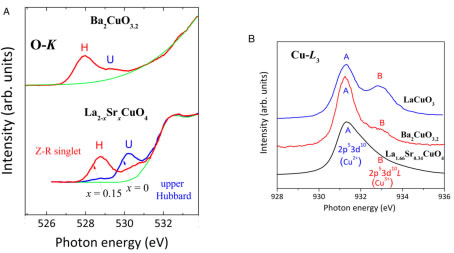Copper oxide high-temperature superconductor (referred to as copper-based superconductor) is the superconducting material system with the highest transition temperature to date under normal pressure conditions. Its microscopic mechanism has been selected into Science 125 major scientific problems. It is still the largest condensed matter science. One of the mysteries and challenges. Due to the strong Jahn Teller effect and interlayer Coulomb effect of copper-based superconductors, the copper-oxygen bond length along the c-direction is larger than the bond length in the copper-oxygen plane, resulting in the basic electronic configuration of the copper-oxygen six-coordinate octahedron presenting a stretch . For the stretched coordination structure, the 3d x2–y2 orbital of copper is located above the 3z2-r2 orbital, and it strongly hybridizes with the in-plane oxygen 2P orbital. This image constitutes the starting point for understanding copper-based superconducting materials (see: Keimer et al Nature 518, 179 ~ 186 (2015)). Researcher Jin Changqing of the Key Laboratory of Extreme Condition Physics, Institute of Physics, Chinese Academy of Sciences / Beijing National Research Center for Condensed Matter Physics and collaborators have long carried out the design and high-pressure synthesis of new structures of copper-based superconducting materials. This is the simplest chemical component capable of forming the basic structure of copper-based superconductors. The unique feature of choosing this simple component is that it can not only focus on the core elements of copper-based superconductivity, but also avoid the expensive and toxic elements such as rare earth, bismuth, mercury, etc. needed for copper-based superconducting materials at atmospheric pressure. Further application and expansion of new materials. Using high-pressure and high-temperature preparation techniques, they have successively discovered the "copper series" (Physica C 223, 238 (1994); Phys. Rev. B 61, 778 (2000)); Chinese Science 48, 87405 (2018)), "top angle "Oxygen" doping system (Nature 375, 301 (1995); Phys. Rev. B 74, 100506 (R) (2006); Phys. Rev. B 80, 94523 (2009) (Editor's Suggestion)), etc. with new structure Copper-based superconducting material system. Among them, the "copper" superconducting material can have a Tc of up to 118K, and was included in the cover of the album commemorating the 30th anniversary of the discovery of the superconducting material in the liquid nitrogen temperature zone (Science Bulletin 62, 3947 (2017)). The systematic research of copper-based superconducting new materials has formed its own characteristics internationally. Through the innovation of 100,000 bar class ultra-high oxygen pressure synthesis technology (MRS Advances 2, 2587 (2017)), Jin Changqing guided graduate student Li Wenmin to discover a new class of superconducting material Ba2CuO4-y. This is currently the only copper-based superconducting material that exhibits a localized coordination of copper and oxygen. For the compression-type coordination configuration, the copper 3d 3z2-r2 orbit will be above the x2-y2 orbit, which is significantly different from the "traditional" stretch-type coordination orbital order. X-ray absorption spectroscopy experiments show that the Ba2CuO4-y superconductor is beyond the doped region, corresponding to the non-superconducting phase region of the "traditional" copper-based superconductor. Existing mainstream theories believe that compressive coordination configurations, exceeding doped carrier concentration, and possible special in-plane structures are not conducive to superconductivity. Ba2CuO4-y still exhibits a superconducting transition temperature of up to 73K . With the same basic crystal structure, the Tc of Ba2CuO4-y is increased by more than 80% compared to the La2CuO4 system with normal orbital order. These experimental phenomena show that, unlike the traditional types in the past, Ba2CuO4-y belongs to a brand-new copper-based superconducting material. The above work was recently published in the Proceedings of the National Academy of Sciences (WM Li et al. PNAS 116, 12156 (2019)). Professor Scalapino, an academician of the American Academy of Sciences and a winner of the Badin Prize, and a famous superconducting theory expert, wrote a special review on the topic of "A different branch of the high Tc family" (A different branch of the high Tc family). Professor QZHuang of the National Bureau of Standards, Professor ZWHu of the Max Planck Institute of Physical Chemistry in Germany, and Uemura of Columbia University in the United States have cooperated closely on the experimental characterization of neutron diffraction, photoelectron absorption spectroscopy and uSR spectroscopy. Professor Uchida participated in the discussion of the experimental results; the research work was supported by major national R & D plans and major international cooperation projects of the Fund Committee. Figure 1. Copper-oxygen bond length of in-plane oxygen and vertex oxygen of copper-based superconducting materials with a single-layer copper-oxygen surface structure, copper-oxygen coordination configuration, relative order of 3d x2–y2 and 3z2-r2 orbitals . Among them, the La-, Bi-, and Tl (Hg) -based oxygen distances at the apex angles are longer than the in-plane copper-oxygen bond lengths, showing a stretched copper-oxygen six-coordinated configuration, resulting in the 3dx2-y2 orbital being above the 3dz2 orbital. The in-plane copper-oxygen bond length of Ba214 is greater than the apex-angle oxygen distance, forming the only compressive copper-oxygen coordination configuration, which results in the 3dz2 orbit above the 3dx2-y2 orbit. Figure 2. Doping concentration measured by X-ray absorption spectroscopy. (A) Ba214 and LSCO [x = 0 (blue) and 0.15 (red)] oxygen K-edge absorption spectrum, U and H are derived from the upper Hubbard band and doped hole state of the O1s core level to copper, respectively, corresponding In Cu2 + state and Cu3 + state (ie Zhang Rice singlet). (B) Copper L-edge absorption spectra of Ba2CuO3.2, overdoped LSCO (x = 0.34) and LaCuO3, indicating that the valence state of Ba2CuO3.2 copper is in excess of the doped state.
Diamond Grinding shoes double bar trapezoidal tool - two abrasive segments are evenly embedded in the metal through a fine manufacturing process.
Strong scraping ability and high durability. Long service life.
-Metal substrate can meet dry/wet applications.
-Commonly used for floor grinding.
PCD grinding shoes arrow-shaped - double PCD gments and two arrow-shaped diamond sectors.
- Application: Floor grinding
Pdc Shoes,Polycrystalline Diamond Compac,Floor Polishing Tools,Floor Grinding Tools Henan Bohong New Material Co., Ltd , https://www.bohongpcd.com
